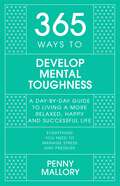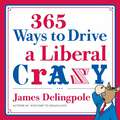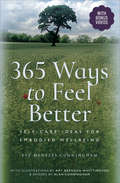- Table View
- List View
365 Ways to Develop Mental Toughness: A Day-by-day Guide to Living a Happier and More Successful Life
by Penny Mallory365 Ways to Develop Mental Toughness is a day-by-day guide to building the confidence and resilience you need to get in control of your life, reach your goals and come out on top.Successful people are mentally tough. And you have to be, because achieving success isn't easy. No one can avoid the minefield of setbacks, crisis, tragedy and challenge that is part of being alive. Life throws obstacles in your path daily, but mentally tough people can manage the stress and pressure. They see challenges as opportunities. They persist no matter what. They pick themselves up and go again. They are confident, humble, in control and 100% committed to what they set out to achieve. That may sound as if mentally tough people are special, but they're not. No one is born with mental toughness - you have to develop it by deliberately working on your resilience, determination, emotional control and focus. Here you'll find a new idea every day to help you do it. Practice them regularly and see the difference it makes. Keep applying them and you will be developing your mental toughness every single day.365 Ways to Develop Mental Toughness focuses on the small stuff you can do every day to make life better. Because when you get the little things right, the big things follow. And today is the very best day to start making those positive changes!
365 Ways to Develop Mental Toughness: A Day-by-day Guide to Living a Happier and More Successful Life
by Penny Mallory365 Ways to Develop Mental Toughness is a day-by-day guide to building the confidence and resilience you need to get in control of your life, reach your goals and come out on top.Successful people are mentally tough. And you have to be, because achieving success isn't easy. No one can avoid the minefield of setbacks, crisis, tragedy and challenge that is part of being alive. Life throws obstacles in your path daily, but mentally tough people can manage the stress and pressure. They see challenges as opportunities. They persist no matter what. They pick themselves up and go again. They are confident, humble, in control and 100% committed to what they set out to achieve. That may sound as if mentally tough people are special, but they're not. No one is born with mental toughness - you have to develop it by deliberately working on your resilience, determination, emotional control and focus. Here you'll find a new idea every day to help you do it. Practice them regularly and see the difference it makes. Keep applying them and you will be developing your mental toughness every single day.365 Ways to Develop Mental Toughness focuses on the small stuff you can do every day to make life better. Because when you get the little things right, the big things follow. And today is the very best day to start making those positive changes!
365 Ways to Develop Your Psychic Ability: Simple Tools to Increase Your Intuition and Clairvoyance
by Alexandra ChauranGo from Intuitive Beginner to Master Psychic in just Five Minutes a DayUnlock and strengthen your innate psychic potential with 365 fast, effective ways to develop your abilities. Beginning with simple observation skills and moving forward to trance and divination techniques, this book’s step-by-step practices guide you to psychic mastery.Formatted to fit your personal pace and learning style, 365 Ways to Develop Your Psychic Ability shows you how to build your psychic muscles day by day. Learn meditation, trance techniques, divination, and how to perform readings. Discover extensive exercises on scrying, clairvoyance, intuition, empathy, and more. Using quick and accessible methods that build upon one another, this comprehensive book helps you become a proficient psychic.
365 Ways to Drive a Liberal Crazy
by James DelingpoleStart every day off RIGHT! Try one of our 365 ways to drive a liberal (even more) crazy. Whether you quote from the Constitution (what, that old relic?) or point out the facts about global warming (as in, the planet has been steadily cooling for the past decade)-this is one sure-fire way to get under a lefty's (thin) skin. Timed to take advantage of the new year, 365 Ways to Drive a Liberal Crazy is the ultimate politically incorrect handbook and is perfect for any conservative, republican, or tea partier!
365 Ways to Energize Mind, Body & Soul: Simplified Characters
by Stephanie L. TourlesEnergize your life through simple steps that promote bodily health and personal peace. From nutritional advice to chanting rituals and visualization exercises, Stephanie Tourles delivers easy-to-implement techniques and friendly advice to help you live life to its fullest. Learn how to boost alertness by taking a walk after a thunderstorm and understand the rewards of music baths. This idea-a-day book will keep you active and focused in a world that seems to grow busier every moment.
365 Ways to Feel Amazing: Inspiration and Motivation for Every Day
by Summersdale PublishersDo you want to be a more amazing you? Tap into the power of happiness every day with this useful collection of self-care ideas, well-being tips, mindful activities and inspiring words. From exercising well to positive thinking, this little book will help you be your best self.
365 Ways to Feel Better: Self-Care Ideas for Embodied Wellbeing
by Eve Menezes Cunningham&“Pull[s] together 366 daily steps to help you live a happier, healthier, freer, and more fulfilled life. Let [Eve] be your inspiring guide for your year&” (Nick Williams, bestselling author of The Work We Were Born to Do). 365 Ways to Feel Better offers simple but effective tools for each day of the year. Eve Menezes Cunningham integrates her background in coaching, counseling, yoga, and other therapies to share practical tools for mind, body, heart, and soul. With an overall aim of supporting people in feeling better in all areas of their lives, Eve encourages the reader to learn to trust in their own capacity to heal and feel better, with a playful approach to their self-care. From goal setting to inner child work, chakras to beneficial yoga poses, breath practices to psychological tools, meditation techniques to aura cleansing, this book offers a taste of a comprehensive range of mind-body tools to help you boost your health and wellbeing. 365 Ways to Feel Better is for anyone who wants to boost their wellbeing in a holistic, side-effect-free way. Self-help fans will enjoy it, but also complementary therapists, energy workers, yoga instructors and yogis, counselors, coaches, and more. &“This book will transform your life. Radical self-care in easy baby steps, what&’s not to love?&” —Suzy Greaves, author of The Big Peace: Find Yourself Without Going Anywhere &“A fabulous book. So very well thought out, planned and executed and with a wonderful accessible yet respectful style.&” —Debra Jinks, coauthor of Personal Consultancy: A Model for Integrating Counselling and Coaching
365 Ways to Find Peace: Meditations & Inspirations
by Marcus BraybrookeNo other book contains such a wide range of accessible, effective and inspiring self-calming techniques, drawn from traditions and literature from around the world, both secular and religious.With a different meditation or inspiration for each day of the year, this is a wonderfully inspiring collection that will open readers' hearts and mind and show them the way to find peace and contentment whatever their mood or situation. A fresh, attractive design featuring sympathetic line drawings adds to the appeal of this gift package.Author Marcus Braybrooke has drawn upon poetry and prose, sacred and secular, from all around the world and from all ages, from the Upanishads and the Tao Te Ching to the speeches of Mahatma Gandhi and the great 19th and 20th-century poets such as Walt Whitman, Rainer Maria Rilke, Wallace Stevens and Seamus Heaney. The inspirations and meditations are arranged thematically, following a structure that reflects the idea of love radiating outward - from self-esteem, the acknowledge of spirit within oneself; through love for family and friends; through love for humankind in general; to love for the One, the spiritual essence that animates all existence. Readers can choose to follow this order, or dip into the book at random, or select an area that they feel particularly drawn to work on.Containing the wisdom of all the world's great spiritual traditions, this is a book that will appeal to people of all faiths, as well as to those who believe in spiritual values without subscribing to a particular religion or even belief in a divinity.
365 Ways to Get Out the Fat: A Tip a Day to Trim the Fat Away
by American Heart AssociationThe latest addition to the bestselling AHA library, this book is chock-full of tips on cooking, shopping, snacking, and preparing and customizing favorite foods, this fact-filled guide makes it easy to keep fat (especially saturated fat) and cholesterol under control--a boon for healthier hearts and trimmer waistlines. 25 line drawings.
365 Ways to Get a Good Night's Sleep
by Maryann Karinch Ronald L Kotler Charles R CantorWe spend about one third of our lives asleep—but we still feel tired. Without a good eight hours, we end up head-bobbing at work and drinking enough coffee to fuel a jet! This book addresses the surprisingly complex issue of sleep in easy-to-tackle steps. This exhaustive guide brings shuteye within reach as it explains how to: Pay back a sleep debt, Nap without throwing off nighttime rest, Deter disturbing dreams, Handle a sleepwalker (or night-eater!), Take a bite out of teeth grinding, and more! It’s usually not a good thing for a book to put you to sleep. But this one-way ticket to dreamland will help you go from counting sheep to fast asleep!
365 Ways to Give Thanks: One For Every Day of the Year
by Brenda ShoshannaThis book is pure feel-good medicine. It gives the reader 365 specific, unique ways of giving thanks on all occasions, birthdays, religious and ethnic holidays, and every other day -- to all kinds of people, even strangers. Focusing on the act of giving, this book shows how easy it is to give back what we have received and how to turn any occasion, even a regular day, into a show of appreciation.
365 Ways to Go Wild: Embrace Your Inner Adventurer Every Day of the Year
by Sam LaceyDream. Explore. Discover.Take a leaf out of nature’s book and unleash your wild side with this essential guide. Packed with hundreds of exciting outdoor ideas and activities, from reading animal tracks to making your own campfire, this little book will guarantee lots of fun and adventure all year round.
365 Ways to Go Wild: Embrace Your Inner Adventurer Every Day of the Year
by Sam LaceyDream. Explore. Discover.Take a leaf out of nature’s book and unleash your wild side with this essential guide. Packed with hundreds of exciting outdoor ideas and activities, from reading animal tracks to making your own campfire, this little book will guarantee lots of fun and adventure all year round.
365 Ways to Have a Good Day: A Day-by-day Guide to Living Your Best Life
by Ian SandersHOW ARE THE NEXT TWELVE MONTHS LOOKING FOR YOU? PRETTY MUCH THE SAME AS LAST YEAR? OR ARE YOU READY FOR BETTER?365 WAYS TO HAVE A GOOD DAY is a full year's worth of daily inspiration, tools, habits, actions, and rituals that will help you live your best life. You'll discover surprising insights from psychologists, business leaders, entrepreneurs and designers. You'll explore the benefits of Feierabends and Laughies, have your eyes opened by a dance psychologist, and find out why one senior executive's tattooed fingers help him make the right career choices. You'll learn habit-forming strategies, pick up helpful hacks, and uncover tips for lasting change - all brought to life through real examples and thought-provoking stories that will get you looking at life differently.You'll meet a cast of characters from around the world who know all about creating success, from the founder of a billion-dollar mindfulness company in California to the Hollywood screenwriter who takes up to eight showers a day to fuel his ideas, and from the Harvard Business School professor who discovered more joy at work by wearing red trainers to the man who every Friday for five years set up a table in central NYC to give advice to strangers, including a gang member on the run.365 WAYS TO HAVE A GOOD DAY focuses on the small stuff you can do every day to make life better. Because when you get the little things right, the big things follow. Things like figuring out where you're going, hitting reset, designing the life you want, breaking through limiting beliefs, and creating success on your own terms. And when you find what works for you, you can do more of it, making you more productive, more fulfilled, and much happier.IT'S TIME TO SEIZE THE DAY. ALL 365 OF THEM.
365 Ways to Have a Good Day: A Day-by-day Guide to Living Your Best Life (365 Series)
by Ian SandersHOW ARE THE NEXT TWELVE MONTHS LOOKING FOR YOU? PRETTY MUCH THE SAME AS LAST YEAR? OR ARE YOU READY FOR BETTER? 365 WAYS TO HAVE A GOOD DAY is a full year's worth of daily inspiration, tools, habits, actions, and rituals that will help you live your best life. You'll discover surprising insights from psychologists, business leaders, entrepreneurs and designers. You'll explore the benefits of Feierabends and Laughies, have your eyes opened by a dance psychologist, and find out why one senior executive's tattooed fingers help him make the right career choices. You'll learn habit-forming strategies, pick up helpful hacks, and uncover tips for lasting change - all brought to life through real examples and thought-provoking stories that will get you looking at life differently.You'll meet a cast of characters from around the world who know all about creating success, from the founder of a billion-dollar mindfulness company in California to the Hollywood screenwriter who takes up to eight showers a day to fuel his ideas, and from the Harvard Business School professor who discovered more joy at work by wearing red trainers to the man who every Friday for five years set up a table in central NYC to give advice to strangers, including a gang member on the run. 365 WAYS TO HAVE A GOOD DAY focuses on the small stuff you can do every day to make life better. Because when you get the little things right, the big things follow. Things like figuring out where you're going, hitting reset, designing the life you want, breaking through limiting beliefs, and creating success on your own terms. And when you find what works for you, you can do more of it, making you more productive, more fulfilled, and much happier.IT'S TIME TO SEIZE THE DAY. ALL 365 OF THEM.
365 Ways to Live Cheap
by Trent HammUse cold water for most clothes washing and save up to $63 a year. Minimize your carload and reduce your gas mileage by as much as 5 percent. Invest in a deep freezer and fill it up with meat discounted at 30 percent or more.Take a look at your life and you'll realize that there's almost always a way to make do on less. This book offers up a bevy of ways to cut down on costs and still enjoy a satisfying lifestyle in any situation. From practicing good gas conservation habits to learning to love leftovers, this book will help every aspiring penny pincher stop the unnecessary spending and find the fun in frugality!
365 Ways to Live Cheap: Your Everyday Guide to Saving Money
by Trent Hamm<p>Use cold water for most clothes washing and save up to $63 a year. Minimize your carload and reduce your gas mileage by as much as 5 percent. Invest in a deep freezer and fill it up with meat discounted at 30 percent or more. <p>Take a look at your life and you'll realize that there's almost always a way to make do on less. This book offers up a bevy of ways to cut down on costs and still enjoy a satisfying lifestyle in any situation. From practicing good gas conservation habits to learning to love leftovers, this book will help every aspiring penny pincher stop the unnecessary spending and find the fun in frugality!</p>
365 Ways to Live Green
by Diane Gow McDildaIt's the choices we make every day that affect our world tomorrow365 Ways to Live Green offers an extended list of opportunities to live with more care for the environment by educating, inspiring and motivating people to look at the choices that are made everyday, and challenging them to change their habits. Broken down into 365 tips, with two concise points per page, readers can use this book to learn to make better everyday choices, from picking safer cleaning products to alternative holidays-this is everyone's all-purpose guide to green living.
365 Ways to Live Green
by Diane Gow McdildaIt's the choices we make every day that affect our world tomorrow...365 Ways to Live Green offers an extended list of opportunities to live with more care for the environment by educating, inspiring and motivating people to look at the choices that are made everyday, and challenging them to change their habits. Broken down into 365 tips, with two concise points per page, readers can use this book to learn to make better everyday choices, from picking safer cleaning products to alternative holidays - this is everyone's all-purpose guide to green living.
365 Ways to Live Green for Kids
by Sheri AmselIn the green conscious world we live in today, parents realize the importance of teaching the lessons of green living, early on. With this book, parents can encourage their children to be ecologically friendly with fun lessons such as: The three Rs: reducing waste, reusing materials, and recycling Why we should keep the air, oceans, and forests pollution free Why organic food is tastier--and better--for you How to protect plants and animals Earth Day celebrations Complete with tips for every day of the year--and activities for home, school, and during playtime--this book reveals how easy it is to be an ecofriendly family--and prepare for a better future together.
365 Ways to Live Happy
by Meera LesterBecoming happier is easier than you think. With this practical, hands-on guide to all things joyful, you can bliss out in no time. You'll learn how to:Lighten up--once and for allWork shorter and play longerPractice pleasing yourself firstAttract more fun-friendly people Go from dull routine to dynamic lifestyleMaster the pleasure principleFind meaning moment by momentForgive, forget, and follow your blissReinvent your happy selves, one day at a timeThis book is all you need to be all you can be, happily!--starting now.
365 Ways to Live Happy
by Meera LesterBecoming happier is easier than you think. With this practical, hands-on guide to all things joyful, you can bliss out in no time. You'll learn how to: Lighten up-once and for all, Work shorter and play longer, Practice pleasing yourself first, Attract more fun-friendly people, Go from dull routine to dynamic lifestyle, Master the pleasure principle, Find meaning moment by moment; Forgive, forget, and follow your bliss; Reinvent your happy selves, one day at a time. This book is all you need to be all you can be, happily!-starting now.
365 Ways to Live Mindfully: A Day-by-day Guide to Mindfulness (365 Series)
by Pascale Engelmajer365 WAYS TO LIVE MINDFULLY introduces simple ways to develop mindfulness habits, such as identifying personal values, developing related goals and setting out to achieve them, through short concepts, ideas, prompts, profiles, practices and exercises, all based on Buddhist thought and practices.The bite-size entries introduce different Buddhist traditions such as mindfulness, compassion, loving-kindness and karma, and profile inspiring past and present figures to guide you towards taking small, impactful steps at your own pace to increase your mindfulness across all aspects of your life and experience noticeable changes that will have a big impact.
365 Ways to Live Mindfully: A Day-by-day Guide to Mindfulness (365 Series)
by Pascale Engelmajer365 WAYS TO LIVE MINDFULLY introduces simple ways to develop mindfulness habits, such as identifying personal values, developing related goals and setting out to achieve them, through short concepts, ideas, prompts, profiles, practices and exercises, all based on Buddhist thought and practices.The bite-size entries introduce different Buddhist traditions such as mindfulness, compassion, loving-kindness and karma, and profile inspiring past and present figures to guide you towards taking small, impactful steps at your own pace to increase your mindfulness across all aspects of your life and experience noticeable changes that will have a big impact.
365 Ways to Live a Buddhist Life: Insights on Truth, Peace and Enlightenment
by Desmond Biddulph Darcy FlynnA beautiful collection of quotations, insights and short tales which form an attractive introduction to Buddhism in all its richness and variety. Great for the newcomer and a multifaceted pick-me-up for the more experienced practitioner. Buddhism has influenced Western thinking like no other Eastern religion. Even people who have no interest in adopting it wholeheartedly acknowledge the wisdom of its philosophical insights. 365 Ways to Live a Buddhist Life covers basic themes of universal relevance such as: the beauty of nature, good and bad karma, the importance of empathy, how to deal with stress and anxiety, how to meditate successfully, how to be happy, and the joy to be found in service to others. Alongside these "pearls" of practical advice there are "lanterns": lucid explanations of key Buddhist concepts that illuminate Buddhist belief and practice, and enlightening accounts of key moments, such as the Buddha's sermon in the Deer Park. The book itself is compact, attractive and beautifully illustrated. Full of accessible Eastern wisdom, this book will help you to find the road to inner peace and happiness.

















